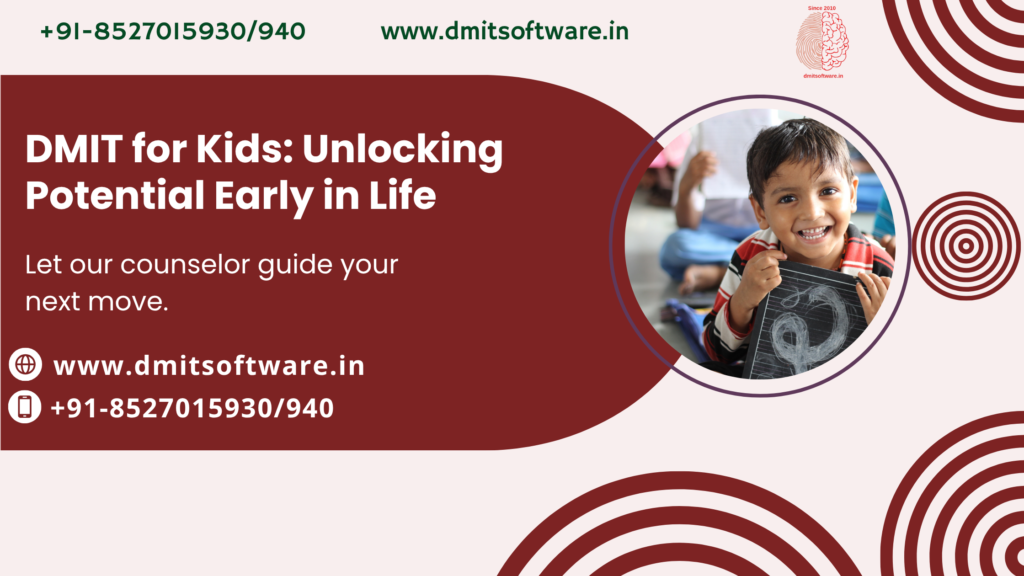DMIT for Kids: Unlocking Potential Early in Life

Understanding a child’s potential early in life is every parent’s dream. What if there’s a way to decode their natural abilities and help them thrive? Enter the DMIT, or Dermatoglyphics Multiple Intelligence Test. This growing trend among parents and educators is transforming how we understand and nurture children. But what is DMIT and how does it work? This blog explores the science behind DMIT, its benefits, and how it’s helping children reach their full potential.
What is DMIT?
The Dermatoglyphics Multiple Intelligence Test (DMIT) is a scientific method used to better understand a child’s capabilities, personality traits, and learning styles by analyzing their fingerprints. Yes, fingerprints! Dermatoglyphics, the study of the unique patterns of ridges on fingers and palms, has been linked to brain development. Since fingerprints are formed between the 13th and 19th week of fetal development alongside the brain, they serve as a map to a child’s innate potential.
Why Fingerprints?
What makes DMIT for kids so intriguing is the correlation between fingerprint patterns and brain functionality. Different regions of the brain are connected to specific types of cognitive and emotional intelligence, and fingerprints provide insights into these connections. For parents and educators, this means gaining a clearer understanding of how a child learns and what they excel in.
How DMIT Works: The Science Behind It
DMIT relies on the principles of neurobiology and dermatoglyphics, blending them together to analyze innate abilities. Here’s how it typically works:
- Fingerprint Analysis:
A professional collects a child’s fingerprints using advanced biometric scanning technology.
- Mapping Intelligence:
The fingerprints are processed to map the connection between each finger and specific brain functions based on established dermatoglyphic theories.
- Comprehensive Analysis:
DMIT generates a detailed report identifying areas such as cognitive strengths, emotional intelligence, learning preferences, and potential career paths.
How Long Does It Take?
The scanning process takes about 15-20 minutes, while the analysis usually takes a few days to generate insights that are easy to understand for parents and teachers.
Benefits of DMIT for Kids
The Dermatoglyphics Multiple Intelligence Test for kids offers many benefits that set it apart as a tool for child development:
1. Personalized Learning Plans
Every child learns differently, and understanding their natural learning style (visual, auditory, or kinesthetic) allows parents and educators to craft personalized study plans.
2. Early Identification of Strengths
Imagine knowing your child’s unique strengths at a young age. DMIT identifies aptitudes in areas like music, mathematics, sports, and creativity, providing a roadmap for their future.
3. Improves Parent-Child Communication
Understanding why your child behaves a certain way is powerful. Parents can better understand their child’s thought process, emotions, and responses after going through a DMIT analysis for kids.
4. Boosts Confidence and Motivation
Children thrive when they work in areas they naturally excel in. By recognizing their abilities, DMIT fosters confidence and encourages skill-building.
5. Career Planning from an Early Age
While no parent wishes to predetermine their child’s future, knowing their innate potential can guide early career exposure. For example, knowing a child has strong logical reasoning skills could inspire an interest in STEM-related activities.
Understanding Howard Gardner’s Multiple Intelligences
DMIT is deeply rooted in Howard Gardner’s Theory of Multiple Intelligences, which posits that intelligence is more than a single general ability. Instead, there are eight core intelligences:
| Intelligence Type | Description | Example Careers |
|---|---|---|
| Linguistic Intelligence | Strong with words and languages | Writers, Teachers, Editors |
| Logical-Mathematical | Skilled in logic, reasoning, and numbers | Engineers, Scientists, Accountants |
| Visual-Spatial | Good at visualizing and understanding space | Designers, Architects, Photographers |
| Musical | Sensitive to sounds and rhythms | Musicians, Composers, Sound Engineers |
| Bodily-Kinesthetic | Excellent physical coordination | Athletes, Dancers, Surgeons |
| Interpersonal | Relates well with others | Leaders, Counselors, Salespeople |
| Intrapersonal | Deep self-awareness | Philosophers, Authors, Therapists |
| Naturalist | Deep connection with nature | Biologists, Conservationists, Farmers |
DMIT incorporates these intelligences into its framework, providing families with insights into which areas their child naturally excels in.
How DMIT Helps in Personalized Learning
One of the standout advantages of DMIT for child development is its ability to foster personalized learning. Education isn’t one-size-fits-all, and DMIT bridges that gap by:
- Identifying Learning Preferences:
If your child absorbs information visually, incorporate more charts, videos, and illustrations. If they’re an auditory learner, encourage reading aloud or using educational podcasts.
- Setting Realistic Goals:
DMIT insights help parents and educators set achievable milestones that focus on honing natural abilities.
- Building Holistic Skills:
Recognizing areas of improvement can guide families to seek extra-curricular activities that nurture the child holistically.
Example:
A child identified as excelling in visual-spatial intelligence could benefit from art classes or even coding, which relies heavily on visual problem-solving.
Real-Life Applications of DMIT
Here are examples of how DMIT tests for children have created positive outcomes:
- Case Study 1:
A 7-year-old struggling academically in traditional school environments was identified as a kinesthetic learner through DMIT. His parents switched to hands-on learning programs, and his performance improved significantly.
- Case Study 2:
An 8-year-old girl showed potential in music according to the DMIT test. After enrolling in piano lessons, her confidence soared, and she even performed in a local competition a year later.
Addressing Common Concerns and Misconceptions About DMIT
Though DMIT fingerprint tests for kids have gained popularity, some parents are naturally skeptical. Here are common concerns addressed:
1. “Is the test scientific enough?”
Yes, DMIT is developed through dermatoglyphic science backed by cognitive research.
2. “Will it pressure my child to follow a specific path?”
Not at all! DMIT focuses on guiding children to explore their potential, not limiting their choices.
3. “What’s the best age for a DMIT test?”
While DMIT can help toddlers as young as 3 years old, the ideal age is between 5 to 15 years when many skills can still be developed.
Discover Your Child’s Potential Through DMIT
Children thrive when their unique abilities are recognized and nurtured early. With DMIT analysis for kids, you can uncover hidden strengths, personalize their education, and help them achieve their fullest potential. Whether your child is an aspiring artist, budding engineer, or future leader, DMIT offers a scientific way to light the path ahead.
Curious to learn how DMIT could benefit your child? Schedule a consultation today and take the first step in unlocking their potential.
